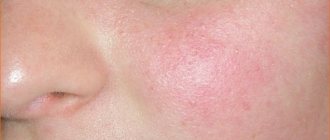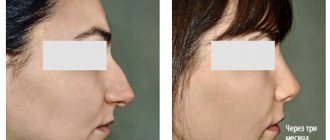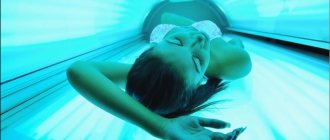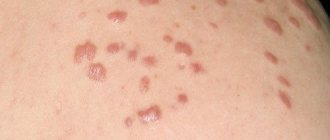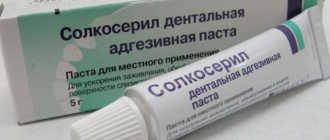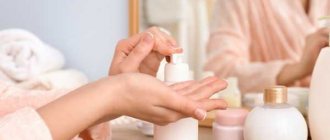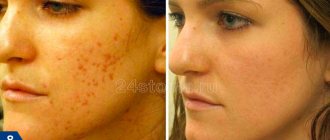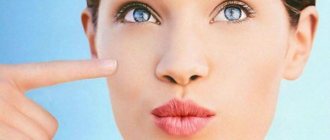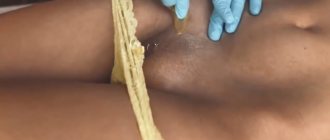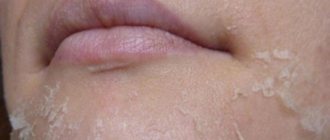A rash on the face is an inflammation of the sebaceous glands. They secrete a special secretion – sebum. Ideally, this is a balanced mixture of various substances produced by the body - fatty acids, steroids, cholesterol, epithelial particles. This “lubricant” protects the surface of the skin from harmful bacteria and serves as an ideal nutritional microflora for it.
Deterioration in the functioning of organs provokes changes in the qualitative and quantitative composition of the secretion and contributes to disruption of its outflow. Sebum goes from being a skin protector to becoming a source of infection. And on the face there is the largest number of sebaceous glands (up to 900 in one square centimeter). The largest of them are located in the area of the forehead, chin, cheeks, wings of the nose, and nasolabial folds. It is not surprising that the rash also “loves” these areas.
Among the dermatologist's recommendations regarding effective treatment, there will certainly be a referral to a gastroenterologist. In some cases, the help of an ENT specialist or endocrinologist is also necessary. But restoring normal functioning of the gastrointestinal tract is the first condition for eliminating the rash.
Causes and etiology
Redness around the nose: the causes usually correspond to dermatological diseases of the skin. In medical practice, women most often suffer from changes in skin color in this part of the face. At risk are teenagers during puberty and women who abuse the use of cosmetics.
Pathological condition of the epidermis: peeling in the nasolabial part of the face, redness caused by a number of negative factors. It is necessary to analyze each possible case in more detail.
Allergic rash on chin
A rash on the chin in women can be allergic in nature. The body is a complex mechanism. When a pathogen penetrates it from the outside, it “turns on” protective functions, which are manifested by various symptoms and manifestations.
Various substances of natural and synthetic origin can act as allergens. For example, food, household products - washing powder, etc.
There are many causes of allergies, the dominant ones being a weakened body, deterioration of the immune system, and a decrease in the body’s barrier functions. Allergy on the chin in medical practice is called perioral dermatitis.
Externally, the pathology manifests itself as small pimples around the mouth. Over time, they acquire a bright red color and grow, affecting large areas.
Etiology of perioral dermatitis:
- Change in climate zone of residence; excessive exposure to direct sunlight.
- High sensitivity to various irritants.
- Long-term use of corticosteroid medications that contain synthetic hormones.
- Hereditary predisposition to allergic reactions. In this case, small pimples on the chin are a fairly common and recurrent phenomenon.
- Disruption of the central nervous system.
The disease is characterized by specific symptoms, which make it easy to diagnose the pathological process. Clinical manifestations:
- The appearance of small pimples on the chin and around the mouth. Sometimes with watery contents. Later they transform into ulcers, discomfort is replaced by pain;
- A feeling of tightness of the skin, severe hyperemia on the lower part of the face;
- Itching and burning around the mouth and chin area;
- Colonial location of the rash.
The formation of acne on the chin may indicate seborrheic dermatitis, diffuse neurodermatitis, steroid acne and other pathological processes. It is almost impossible to independently determine the source. The reasons are determined after a thorough comprehensive examination. Based on the results of instrumental and physical diagnostics, therapy is prescribed.
is a common dermatological disease that is characterized by the appearance of rashes or pimples around the mouth. Most often, young women suffer from perioral dermatitis. Rash and pimples around the mouth, which are observed against the background of perioral dermatitis, should be distinguished from ordinary acne. The exact cause of perioral dermatitis is not known. Treatment for perioral dermatitis includes stopping the use of any cosmetic products (especially creams with steroid hormones) and long-term treatment with antibiotics.
What does perioral dermatitis look like?
Typically, with perioral dermatitis, small red or pink bumpy spots or small pimples appear on the skin around the mouth. The rash may also appear on the chin, cheeks and under the nose. The rash is very similar to acne (blackheads), but it is not acne. The skin under and around the bumps often has a red or pink tint. The skin is rough to the touch, due to multiple small tubercles. Over time, age spots may remain in place of the bumps and pimples. As a rule, the strip of skin that is located directly around the lips is not affected, or is much less affected than areas of skin further away from the mouth (the pale “ring” around the mouth). In some cases, perioral dermatitis also affects the skin around the eyes, especially the temples.
With perioral dermatitis, the intensity of the rash can vary from a few inconspicuous bumps to a pronounced rash. Typically, perioral dermatitis does not cause pain or itching. However, some patients with this problem complain of a slight burning or itching in the area of the rash. This skin disease does not pose a health hazard, but causes trouble for patients due to the cosmetic defect it creates.
skin disease
correct treatment
Antibiotics for the treatment of perioral dermatitis
Most often, rashes on the face appear in the chin area, since it is this area that is consciously or unconsciously touched with hands, mostly with dirty hands. And then various bacteria, viruses, allergens fall from the fingers onto the skin of the face, which contributes to the occurrence of acne, herpes, contact dermatitis, etc. A more serious reason why a chin rash appears in adults may be the presence of some kind of internal disease. In any case, to get rid of acne, you need to understand the nature of its occurrence.
Rosacea: symptoms
Rosacea is a long-term reddened condition of the facial skin. Additional signs: superficial vasodilatation, papules, pustules and swelling. Symptoms characterizing this disease:
- facial hyperemia – increased blood flow. A person may feel sudden rushes of blood (short and fast). The skin on the face turns pink, there is a feeling of warmth on it;
- redness on the nose, its sides and partly on the cheeks;
- the nose swells;
- red large pimples;
- cystic acne may appear;
- oily skin on the forehead;
- dryness, itching in the eyes - in some cases.
The appearance of acne is often caused by hyperemia. It is this disease that aggravates rosacea and turns the problem into a chronic one. First, the tip of the nose acquires a reddish tint, and the pigmentation spreads to the bridge of the nose. As soft tissue grows, the nose becomes slightly enlarged and deformed. This disease is most often diagnosed in women who are postmenopausal.
Negative factors that provoke this condition:
- eating spicy food;
- alcohol abuse;
- face mite infestation;
- intestinal infections.
Rosacea is not dangerous, but it brings aesthetic and psychological discomfort.
Perioral dermatitis: photos, treatment, causes and symptoms
Perioral dermatitis (rosacea-like, perioral) is an inflammation of the skin around the mouth, which is accompanied by redness, swelling and rashes in the form of papules.
This is a rare dermatological disease, it is diagnosed in 1% of patients, most often in women under 40 years of age.
Perioral dermatitis creates physical and mental discomfort and requires qualified treatment and prevention.
Features of perioral dermatitis
Perioral dermatitis on the face begins with the appearance of several small red pimples along the lip line. Then the skin around the mouth becomes red, the number of pimples increases, they burst, dry out, and crusts form. After healing, dark spots remain. A strip of healthy skin is maintained between the lips and the affected area.
The disease begins with an acute form , symptoms do not appear immediately, the causes can be external and internal. If left untreated, it becomes chronic and worries the patient all his life - periods of recession are followed by periods of exacerbation.
Oral dermatitis can be caused by a medicine or cosmetic cream containing corticosteroids. They affect small vessels of the epidermis and destroy the structure of elastins and collagens. This leads to the development of erythema and microcracks appear on the skin.
The disease is accompanied by rashes in the form of papules, which gradually merge into large plaques. If the rash is granulomas, a granulomatous form of dermatitis develops, which is often observed in children.
You can see what the disease looks like at different stages in the photos below.
The main
symptom of perioral dermatitis is a rash around the mouth.
They are papules in the shape of a hemisphere, filled with colorless liquid. The rash has a red or red-pink color; when pressed, it bursts, and after a few days a crust of dry brownish scales forms in the area of the rash.
The rash appears around the mouth, sometimes around the eyes, on the nose and cheeks.
There are other symptoms:
- Itching and burning in the chin area.
- Feeling of skin tightness.
- Rashes (small red papules).
- Redness, swelling, dryness of the epidermis.
- Crusts in the form of scales (after opening the papules).
- Increased intensity of redness due to temperature changes, alcohol consumption, spicy or hot foods.
- Symmetry of affected areas.
- A strip of healthy skin 2-4 mm wide around the lips.
- Skin pigmentation after healing.
Determining the specific cause of oral dermatitis on the face is problematic; examination and examination by a dermatologist is required.
He prescribes tests and, based on the results, treatment that is aimed at relieving symptoms and eliminating causes.
The main provoking factors are:
- Weakening of the body's immune defense.
- Climate change.
- Exposure to sunlight.
- The use of hormonal ointments and creams.
- Genetic predisposition.
- Tendency to allergies.
Allergic perioral dermatitis can be caused by cosmetics that include:
- Petrolatum.
- Paraffin.
- Isopropyl myristate.
- Sodium lauryl sulfate.
- Cinnamon-based flavors.
Dermatitis around the mouth in children develops regardless of gender and age.
In newborns, the cause of the disease is insufficient care, exposure to saliva on the skin and the mechanical effect of the pacifier rim, violation of feeding rules, and incorrectly selected baby care products.
In children under 13 years of age, granulomatous perioral dermatitis, which is a type of rosacea, is most often diagnosed. In this case, the nature of the rash and some symptoms differ.
If the disease is allergic in nature, it is enough to exclude exposure to the irritant; if the etiology is different, it is a provoking factor. For treatment, local remedies are used, in extreme cases antibiotics, anti-inflammatory and antibacterial drugs.
diagnose oral dermatitis ; this requires an examination and questioning. He prescribes dermatoscopy, excludes acne, eczema, herpes and demodicosis.
- To study the microflora, bacterial culture of rashes or scrapings from the affected skin is carried out. Often the analysis results show an excess of the norm for Candida and Acne fungi.
- Skin tests for staphylococcal and streptococcal infections indicate increased sensitivity to bacteria.
- If rosacea is suspected, a culture test for this disease is performed.
- The histology of the affected skin is prescribed due to the absence of a characteristic picture of the disease, the background of which is subacute inflammation and partial atrophy of the skin around the mouth.
- General and biochemical blood tests do not show significant changes, only sometimes the ESR increases slightly. But this can be caused by concomitant chronic diseases.
With perioral dermatitis, there is a decrease in immunity, increased activity of T-lymphocytes, an increase in the number of immunoglobulins, and a decrease in the concentration of complement. In some patients, the functioning of the adrenal glands is disrupted, which causes hormonal imbalances. The number of microbes on the affected areas is several times greater than on healthy skin.
A positive result guarantees correct and timely treatment. The full course ranges from two weeks to several months. Since relapses often occur after therapy, constant support of the immune system and compliance with a number of rules are necessary. Treatment of perioral dermatitis is carried out in three stages : zero and main therapy, prevention.
Zero therapy. Complete avoidance of facial cosmetics, fluoride toothpaste, hormonal medications, ointments and creams containing corticosteroids. Use of hypoallergenic hygiene products.
Basic therapy. Taking the following medications:
- Antibiotics.
- Antihistamines (for allergic etiology).
- Diuretics (with pronounced swelling).
- Sedatives (to reduce discomfort).
- Nicotinic acid.
- Vitamins B6.
If the dermatitis spreads to the eyes, you will need to consult an ophthalmologist.
He will prescribe antibacterial eye drops and Riboflavin injections.
In addition to medications, diet contributes to rapid recovery.
Authorized products:
- Wholemeal bread.
- Dairy products.
- Cereals.
- Legumes.
- Greens, vegetables, fruits.
- Lean boiled meat.
- Prohibited products:
- Eggs, sausage.
- Fish, caviar.
- Mushrooms, carrots, citrus fruits.
- Spices.
- Tea, coffee, alcohol.
Salt and sugar are allowed in limited quantities.
You need to drink at least 1.5 liters of water per day - it will improve your metabolism and provide your skin with the necessary microelements.
Skin care for oral dermatitis includes the use of medications, ointments, creams, and traditional medicine.
For rashes, you need to treat the affected areas 3-5 times a day with decoctions of yarrow, calendula, celandine, and St. John's wort. To prepare the decoction, 2 tbsp. spoons of raw materials, pour 200 ml of boiling water, leave for 2-3 hours in a warm place. Strain and pour into a container with a tight lid. Use for wiping and lotions.
It is recommended to use medicinal compresses made from honey, onions and flaxseeds. Mix thoroughly 1 tbsp. spoon of each component, boil for 15 minutes in a water bath, strain, pour into a glass container.
Soak gauze in the mixture, apply to the affected areas for 1 hour, remove the bandage, wipe your face with a decoction of herbs.
Skin with dermatitis around the mouth can be treated with glycerin borax, soda solution, infusion of chamomile, plantain, St. John's wort.
Even in its acute form, perioral dermatitis creates physical and aesthetic discomfort - neuroses and depression. With self-medication or lack of treatment, the disease becomes chronic and causes complications. The rash spreads over the entire face, affecting the eyes and ears.
Damage to the skin (ulcers, pustules and scratches) are a simple and easy way for infection to enter the body. After recovery, pigment spots, scars and scars may remain on the face. The skin will remain dry, pale, and a feeling of tightness will remain.
When certain conditions are created, the disease will occur again and again, periods of regression will alternate with relapses.
A quick recovery is ensured not only by correct and timely treatment, but also by compliance with preventive measures. To do this, follow these recommendations:
- Avoid the cosmetics you used before your illness.
- Avoid using toothpaste that contains fluoride.
- Wash with hypoallergenic soap.
- During periods of exacerbation, take antihistamines.
- For edema, use diuretics.
- After washing, dry with a clean towel, do not rub, but blot.
- Follow your diet.
- Take vitamins to support your immune system.
- Avoid hypothermia.
Do not forget that in most cases the chronic form of perioral dermatitis is diagnosed. Therefore, it is important to carry out preventive measures during and after treatment to prevent recurrence of the disease. Don't give up on antibiotics. These can be ointments, creams or tablets.
The most common of them is tetracycline, for external use - Erythromycin and Metronidazole. Be patient and remember - treatment of oral dermatitis takes a long time (up to 3 months) and requires a lot of effort.
A positive result can only be obtained if you follow the treatment regimen and doctor’s recommendations.
Source: https://dermatit.su/types/perioralnyj/
Perioral dermatitis
Redness of the skin around the nose and under the eyes in the form of red pimples and peeling are symptoms of perioral dermatitis. This disease manifests itself in the form of eczema. It mainly affects the mouth and lips area. Among the causes of occurrence are the following:
- long-term use of nasal sprays, creams containing topical steroids;
- the use of cosmetics based on petroleum jelly or paraffin;
- certain types of toothpastes;
- bacterial and fungal infections.
Symptoms of perioral dermatitis:
- a red rash on the sides of the nose, in the folds under the nose and eyes, also on the chin and forehead;
- in severe cases, the rash manifests itself in the form of peeling on inflamed areas of the skin;
- burning and constant itching.
The disease can appear at any age, regardless of gender and race. Young women and teenagers are most often affected.
Experts in the field of dermatology say that recurrence of perioral dermatitis can cause chronic rosacea.
Treatment measures at home
If you suspect that a fungus has settled under your nose and the disease is in its initial stages, you can try to cope with it using available local remedies:
- Clotrimazole ointment has been known for a long time, has stood the test of time, tested by many, is an inexpensive and effective remedy. Apply to the affected areas with a small swab of healthy skin several times a day. Sometimes one or a couple of days are enough for the painful manifestations to subside. But it is still worth extending the use of the ointment until the signs of the disease completely disappear and guarantee its non-recurrence. This process (on average) takes up to two to four weeks.
- Miconazole ointment is a drug that has a detrimental effect on almost all types of fungal infections. It should be used in the same way as Clotrimazole. Due to the lack of deep penetration into the skin, both drugs practically do not accumulate in tissues and have almost no side effects.
- Terbinafine cream - apply a thick layer in the morning and at night. Kills many types of fungi. Sometimes it causes a slight burning sensation at the site of application, which quickly passes and does not lead to discontinuation of the medicine.
- Our grandparents were also treated with salicylic ointment. It does not touch the fungus itself, but disinfects the surface of the skin and promotes its rapid recovery.
- Zinc ointment is used in cases where the folds under the nose become excessively wet. It allows you to stop this process, exhibiting a drying and astringent effect.
- Sebozole - has a good antifungal effect in patients with hypersensitivity.
Along with local medications, systemic antimycotic drugs are used for internal use. The most famous of them are Nystatin, Lamisil, Fluconazole. They are effective, but have significant contraindications and side effects.
A mild form of fungus under the nose can be overcome by traditional medicine. They have proven themselves well as assistants in prevention. This:
- Tea tree oil . A few drops are mixed with a teaspoon of any refined vegetable oil. Lubricate the area near the nose several times a day.
- Infusions of medicinal herbs . Calendula, chamomile, oak bark, individually or in combination, are brewed with boiling water and infused to a temperature that is pleasant to the body. Problem areas are treated with a moistened swab or cotton swab.
- Aloe or Kalanchoe juice . The washed plant leaves are placed in a piece of bandage and kneaded until the juice appears. To avoid scratches, thorns on aloe leaves must be removed. Apply as mini-compresses for 10-15 minutes.
Seborrheic dermatitis
Redness and flaking of the facial skin around the nose are sure symptomatic signs of seborrheic dermatitis. The disease manifests itself on the face, around the nose, around the eyes, on the forehead and affects the scalp. Seborrheic dermatitis is a chronic disease, but is not transmitted.
Seborrheic dermatitis is caused by yeast-like fungi. This is a disease of the sebaceous glands. Thus, when exposed to chemical, physical, mechanical and thermal irritants, with a decrease in immunity, the activation of fungi is provoked. They multiply and appear in significant numbers. The skin on the nose turns red and becomes covered with peculiar ulcers.
Forehead
A large number of sebaceous ducts are concentrated in the forehead area. If the sebaceous glands work in increased mode, sebum clogs the ducts and acne appears. The main hormone that affects the activity of the sebaceous glands is testosterone. Therefore, rashes on the forehead are a hallmark of teenage hormonal storms.
It is also believed that the forehead is a projection of the intestinal area. If the rash is localized in the upper area of the forehead, there may be problems in the large intestine; if in the lower area, attention should be paid to the small intestine.
Demodicosis
This is a fairly rare dermatological disease. Demodectic mange is caused by a subcutaneous parasitic mite. Experts believe that 97% of the inhabitants of planet Earth have such microorganisms. However, their manifestation is caused by decreased immunity, a severe emotional state and great stress experienced.
Demodicosis occurs in pregnant women and those who suffer from hormonal diseases. Without special equipment, it is impossible to identify the subcutaneous parasite.
Cuperosis
This is a serious disease of vascular-cutaneous pathology. As a result of the pathological process, the vascular walls become less elastic and thin. Spider veins appear on the nose of patients.
Cuperosis is not a cosmetic problem, but a serious illness. When the capillary walls are weakened, paralysis of muscle fibers occurs.
Allergic reaction
Dust, mites, seasonal flowering of certain plants, animal hair, cosmetics are the reasons that cause redness of the facial skin around the nose. This is all an allergic reaction of the human body to external irritants.
The mucous part becomes inflamed due to hyperemia (dilation of the capillaries), and severe swelling of the skin occurs. Redness of the nose is one of the symptoms.
Frequent use of a handkerchief can cause skin irritation.
Causes of the disease
A rash of varying sizes on the chin in women or men, the causes of which may be related to the influence of allergens on the body, should not be ignored. Irritation on the chin can occur under the influence of the following factors:
- reaction to cosmetics and personal hygiene products (for men - to aftershave products);
- negative impact of the environment;
- bad habits (response to increased stress on the body);
- consequences of infectious diseases;
- increased load on the nervous system (stress);
- negative influence of parasites in the body;
- hormonal surges and disruptions (90% occur in women);
- contact with fur or saliva of domestic animals (including ornamental rodents and birds);
- seasonal allergies associated with flowering trees and various grasses;
- negative consequences of taking medications (overdose, side effects, allergy to a component of the drug);
- insect bites;
- reactions to climatic conditions;
- influence of food components;
- reaction to ultraviolet radiation (sun, visiting a solarium).
One cannot ignore the fact that a rash on the chin can appear under the influence of dust (book, household, industrial) - it contains irritants that can provoke an allergic reaction.
Interesting! If your chin is very itchy after eating food, then the reaction may be associated with the negative influence of one or more components: flavorings, dyes, preservatives.
Lupus pernio: what kind of disease, symptoms and causes
Redness on the face around the nose is a form of manifestation of lupus pernio. This is a form of cutaneous sarcoidosis. The color change occurs due to an increase in the vascular network. The color of the redness can vary from a reddish tint to purple. Changes in skin color can affect not only the nose area, but also the cheeks, lips and ears. At the same time, the skin in the inflamed areas shines and swells.
The disease most often affects women between 45 and 65 years of age.
Symptoms of lupus pernio are not clearly visible. There may be slight itching or pain when pressed. Cosmetic external disfigurement is a common complaint. The cause of the disease is still unclear.
Treatment of perioral dermatitis, symptoms, causes
Update: September 2019
Perioral dermatitis - in medicine it is also called rosacea-like or perioral dermatitis. This is a rare disease, occurring in approximately 1% of the population, most often in women 20-40 years old.
With perioral dermatitis, small papules and pimples appear on the skin around the mouth and on the chin, the skin turns red, irritation appears and papules grow over a larger area.
This creates considerable aesthetic, physical and psychological discomfort for a person.
This is how most patients describe the onset of the disease - “... recently I noticed that several small red pimples had formed on my chin, I began to use acne cream and wash my face more often, but this only made it worse.
Within a few months, the skin around the mouth and chin became simply red, and when the acne healed, it left dark spots. Moreover, between the lips and the affected areas around the mouth there is a clear strip of healthy skin without redness...”
Symptoms of perioral dermatitis
If these symptoms appear:
- Pain, itching, burning, redness, a feeling of tightness of the skin, and small red pimples appear in the area of the chin and mouth.
- Pimples may have heads that release clear liquid when emptied; over time, pimples become ulcers.
- Pimples form colonies, group clusters
- The skin in the inflamed areas begins to become covered with thin transparent scales, which then fall off
Most likely, this skin inflammation is caused by perioral dermatitis. But to clarify the diagnosis, you should definitely consult a dermatologist, since the appearance of acne and irritation on the face can be due to other reasons:
To isolate the microflora of the lesion site and determine the pathogen, a bacterial culture of the scraping or contents of the rash is carried out.
The skin around the mouth may not be changed and present a normally colored border of up to 2 cm. Usually, the rashes are located on slightly reddened skin or the skin does not change color.
Causes of perioral dermatitis
- Decreased humoral and cellular immunity
- Climate change, excessive exposure to ultraviolet radiation
- Increased sensitivity to bacterial allergens
- Long-term or even short-term use of topical corticosteroids in the form of creams, ointments (see a
complete list of all hormonal creams and ointments - Psoriasis Ointments) - Predisposition to allergic reactions, presence of allergic rhinitis, bronchial asthma
- Quite sensitive facial skin
- Excessive use of various facial cosmetics
- Hormonal imbalance in gynecological disorders
- Use of dentures, toothpastes containing fluoride
- Disorders of the gastrointestinal tract, nervous system, endocrine system
If dermatitis is caused by cosmetics, carefully study the composition of all creams, lotions, etc. Here is a list of some ingredients that most often cause perioral dermatitis:
- Paraffin
- Sodium lauryl sulfate
- Cinnamon flavors
- Isopropyl myristate
- Petrolatum
Treatment of perioral dermatitis
Treatment of this skin disease is quite long, the duration of therapy ranges from 1.5 to 3 months and depends on the severity of the manifestations of perioral dermatitis.
Treatment of perioral dermatitis is prescribed by a dermatologist, and the sooner you contact a specialist, the more effective the result will be.
Even with proper treatment, relapses of the disease are possible in the future, but they are much easier and are eliminated faster.
The use of corticosteroids (hormonal ointments, creams) for perioral dermatitis is contraindicated.
Zero therapy
The first thing that is recommended to be done after diagnosis is called zero therapy. That is, cancel all ointments, creams, cosmetics used, especially with corticosteroid substances, and also change the toothpaste to regular one. In this case, the condition may worsen for some time, and then after a few weeks it should improve.
Antihistamines
At this time, it is possible to use antihistamines (Suprastin, Cetrin, etc., see All allergy tablets), sodium thiosulfate, calcium chloride.
Antibiotics
For oral dermatitis, treatment with antibiotics is quite effective. The administration of Metronidazole gel or cream 0.75% or Erythromycin gel 2% stops the progression of the disease. Apply the product 2 times a day until the rash stops.
The doctor may prescribe an oral antibiotic - this is Minocycline or Doxycillin 100 mg 2 times. per day until the rash goes away, then for a month, 100 mg once a day and another month, 50 mg per day. And also taking Metronidazole orally (this is not an antibiotic, but an antiprotozoal drug).
Or Tetracycline according to a similar regimen, only 500 mg/2 times, then 500 mg/1 time and 250 mg/1 time. After starting the use of antibiotics, deterioration may occur, but after 3 weeks the condition of the skin usually improves noticeably.
Elidel Cream (Pimecrolimus)
Pimecrolimus can be used for oral dermatitis only as prescribed by a doctor when other treatments are ineffective.
Elidel is a cream that has long-term adverse effects; the effect of the drug has not yet been fully studied, but it is believed that pimecrolimus suppresses the secondary immune response and there have been cases of the development of skin tumors and lymphomas after its use. Therefore, the use of this remedy should be treated with caution.
Skin care for perioral dermatitis
For this disease, gentle facial skin care is recommended. After washing, you should not wipe your face with a towel, but only blot it. The doctor can select for you indifferent powders, cooling, moisturizing creams that do not contain substances that aggravate the symptoms of the disease. (see Allergy creams, dermatitis ointments)
Herbal infusions
In the case of an acute process, to relieve symptoms, you can use cooling lotions made from chamomile infusion (if there is no allergy) or 1% boric acid, as well as from infusions of St. John's wort, celandine, and calendula.
Normalization of the general condition of the body
If there are foci of infection, then treatment of concomitant diseases is necessary, as well as normalization of the endocrine and nervous systems, and the functioning of the gastrointestinal tract.
If necessary, general strengthening, immunostimulating drugs, and drugs that normalize the function of the central nervous system are prescribed.
Monthly courses of vitamin therapy, B vitamins, vitamin C and A, and folic acid are recommended.
Systemic lupus erythematosus
Lupus is an autoimmune disease. In this disease, the immune system mistakenly attacks healthy tissue.
Symptomatic manifestations of the disease can begin in adolescence and up to 30 years.
Redness around the nose, fatigue, fever, dry mouth, and joint problems are common symptoms of lupus.
The skin rash on the face resembles the shape of a butterfly. This is why it is popularly called “butterfly rash.” However, a rash is not always characteristic of the manifestation of this disease.
Preventive measures for facial allergies
A properly selected course of treatment will help get rid of external and internal manifestations of allergies. But every contact with an allergen will worsen a person’s condition, which will lead to resumption of the disease. To avoid relapse, you must follow a few simple rules. The main preventive measures are:
- Compliance with a special therapeutic diet.
- Introducing foods rich in vitamins, minerals and other nutrients into the diet.
- Elimination of all kinds of stress, emotional experiences and overexertion from life.
- Choose household chemicals carefully.
- Active sports.
- Choose all cosmetic products correctly.
- Compliance with personal hygiene rules.
- Clean and ventilate the apartment regularly.
- When exposed to the sun for a long time, use special skin protection products.
- During treatment, strictly adhere to the dosage prescribed by the doctor, as well as the period for taking the medications.
Allergic reactions on the face are extremely unpleasant phenomena. They bring a person not only a feeling of discomfort, but also a lot of negative emotions. All this together can negatively affect a person’s future life. Therefore, if you notice the first symptoms of an allergy on your face, you should immediately seek qualified medical help. Only qualified specialists will be able to quickly and accurately make the correct diagnosis, on the basis of which an optimal further treatment regimen will be developed.
CPAP mask
People suffering from acne or sleep apnea often resort to using a CPAP mask. This is special equipment. Due to the strong tension of the belts, redness around the nose occurs almost immediately. Using this mask may cause serious inflammatory skin disease. Ulcers may appear on the skin of the face.
Solution to the problem: choose an alternative method of acne treatment.
Other reasons
Other reasons can cause redness and peeling of the skin around the nose:
- abuse of drugs that affect the cardiovascular system;
- ARVI is a respiratory infection of viral origin, acute rhinitis is a clear symptom;
- rhinophyma - benign tumor-like skin lesion;
- acne vulgaris, a manifestation of hormonal imbalance, chronic endocrine pathology and improper facial skin care;
- avitaminosis;
- psychoneurological abnormalities - stressful situations, anxiety contribute to the dilation of blood vessels on the skin of the face, blood microcirculation is disrupted;
- formation of subcutaneous acne;
- single pimples;
- cuts or scratches;
- burns;
- long walks in the cold.
If you detect the first external manifestations of redness on the nose, you should urgently consult a doctor. Timely diagnosis of the disease will help you quickly begin proper treatment.
Rash under the nose in adults: causes and recommendations
A rash under the nose causes a lot of inconvenience, but identifying the causes of its appearance can be quite difficult. Only a dermatologist who has studied your medical record can determine them accurately. A rash around the nose brings not only aesthetic inconvenience, but also severe discomfort, and if infected, can pose a serious threat to human life.
Causes of rashes under the nose
The causes of a rash near the nose can be different. Rashes in the nasal area can be caused by:
- runny nose;
- allergy;
- insufficient hygiene;
- violation of the rules of care.
On sunny days, the appearance of a rash under the nose is caused by exposure to ultraviolet rays on the skin. The skin often reacts with a rash due to allergies: to foods, medications. In addition, a rash may appear due to changes in the quality of water, both drinking and washing.
Important! Errors in diet can lead to the appearance of rashes, especially if you have gastritis or oily skin. Most often, the causes of a rash under the nose are associated with factors that do not pose a danger to the body and can be easily corrected.
Rash under the nose in adults
Tray rashes often appear in the area of the nasolabial triangle. This is caused by increased activity of the strong glands in this area. Excessive oil production causes rashes. If an infection gets into the pores, but the raw material can degenerate into pimples or blackheads.
Poor hygiene or improper skin care often causes a rash under the nose in adults. Thus, alcohol-containing products irritate the skin and cause irritation. To cleanse the skin and remove excess sebum, products with antibacterial and anti-inflammatory effects should be used. Also the reason may be:
- Using dirty towels and bed. Dirty bed and towels are an excellent environment for pathogens that cause skin irritation. Don't forget to change your linens promptly and store your towels on a heated towel rail rather than on a clothesline.
- Errors in diet. A rash in the nasal area often appears due to diet disorders. Smoked foods, fatty meats, spices, foods with a lot of sugar, carbonated drinks, and alcohol can trigger rashes on or around the nose. You can get rid of rashes only by correcting your daily diet.
- Intoxication of the body. When intoxicated, the body cannot cope with the stress, resulting in irritation on the skin. Intoxication can be caused by poisoning, fever, liver disease.
- Violation of the rest regime. Insomnia or improper daily routine (late rising, sleepless nights) can cause rashes on the skin, most often the area around the nose, forehead and chin is affected. Also, the appearance of acne or rashes can be caused by sleeping under a warm blanket, which causes a person to sweat a lot.
Please note: bedding and towels must be changed weekly, otherwise they accumulate pathogens that cause rashes and pimples.
- Changes in hormonal levels. Rashes appear due to hormonal imbalance. Women may also experience it before or during menstruation. Men also have physiological cycles that affect hormonal levels and can cause regular skin irritations. In addition, endocrine system disorders are often accompanied by a rash.
- Gastrointestinal diseases. Digestive system disorders always affect the condition of the skin. The cause of the rash may lie in a disruption of the stomach or intestines. Diarrhea or constipation can also cause a rash under the nose, forehead or chin.
- Dermatitis. A small red rash is a sign of dermatitis, which can occur due to an allergic reaction. With dermatitis, rashes appear gradually: the skin turns red, then pimples or nodules form on it. They may merge into one spot or spread to other areas, but the area around the lips remains clean.
Important! Chronic diseases cause serious deviations in the functioning of the skin. However, rashes and pimples disappear after the acute phase of the disease is over.
- Acne. Adults often suffer from acne. The lesion begins with redness of the skin, later small pustules form. The formations are accompanied by pain and itching.
- Purulent acne. Pimples with pus can be multiple or single. They can occur not only due to hormonal disorders or insufficient care, but due to a deficiency of minerals and vitamins, weak immunity and poor nutrition.
- Subcutaneous acne. These pimples are not that noticeable, but they cause discomfort. They may be reddish or the color of healthy skin. The rash protrudes slightly above the skin and is painful.
- Increased sweating. Sweat under the nose often irritates the skin. Sweating can be caused by stressful situations, physical activity, hot weather, too warm clothing or physiological characteristics of the body.
- Runny nose and its consequences. When you have a runny nose, the skin under the nose suffers from secreted mucus, as well as frequent rubbing with paper or cloth handkerchiefs. As a result, a rash forms under the nose. The affected area turns red, peels, and may have small red dots or pimples. With a bacterial runny nose, the skin can also be infected with pathogenic organisms, and then the redness under the nose may not go away even after the runny nose is cured.
Recommendations for rash around the nose
To prevent rashes in the area of the nasolabial triangle, general recommendations should be followed:
- Conduct a cosmetics audit. This will help you get rid of expired products that caused irritation;
- If you have a runny nose, use a paper tissue, which should be thrown away immediately. Wet tissues promote the spread of bacteria on the skin in the nose area;
- With frequent rashes, it is necessary to introduce more foods rich in minerals, vitamins and fiber into the diet;
- Change bed linen and towels more often;
- Use antibacterial facial skin care products.
Attention! Do not squeeze or scratch rashes and pimples in the nose area. The nasolabial triangle is the most vulnerable area of the face, which has no physiological protection. Infection of the rash in the nasal area can cause serious abnormalities and leave scars. In addition, the infection can enter the bloodstream.
Important: if you regularly experience a rash under your nose that is not related to your cycle, you should consult a doctor. You should not only conduct an examination by a dermatologist, but also check the internal organs for pathology.
Rate this publication: Loading...
Source: https://IDermatolog.ru/allergiya/syp/prichiny-poyavleniya-sypi-pod-nosom-u-vzroslogo.html
When to see a doctor?
Redness around the nose is a symptom of various pathologies. If your nose remains red for a long time, you should consult a dermatologist. Diagnosis of the disease includes a general blood and urine test, biochemical blood test and others.
Additional symptoms should cause severe anxiety in a person:
- chills, deterioration of health, fever;
- purulent discharge on the nose;
- the appearance of painless formations on the walls, back and wings of the nose;
- the skin on the nose thickens, and the nose visually increases in size.
You should not prescribe treatment on your own. You should immediately consult a doctor without neglecting the symptoms.
Rash under a child's nose
For every parent, the most important thing is that the child grows up healthy. But sometimes unpleasant moments happen that cause anxiety. This also happens when rashes appear under the nose. However, only a specialist can determine their nature.
Causes and mechanisms
The child's skin should be clean. If some kind of rash is visible on it, then first of all you need to determine its nature.
In newborns, small transient pimples sometimes appear on the face, associated with hormonal changes in the body (the influence of estrogen received from the mother).
These are the so-called milia or white millet-like nodules, which are a sign of a sexual crisis. But such a rash is physiological, goes away on its own and should not cause alarm.
In other cases, most likely, you need to look for some kind of disorder in the child’s body. They can be provoked by external or internal factors, which one way or another require elimination. Among the causes of a rash under a child’s nose, the following should be noted:
- Allergies to food, cosmetics, animal hair, pollen, medications, etc.
- Heat rash due to overheating.
- Deficiency of vitamins and minerals.
- Insufficient hygiene.
- Helminthic infestations.
- Infectious diseases.
The last group is the most extensive, because it can include many childhood diseases. Scarlet fever, measles, rubella, chicken pox - all these diseases can be accompanied by rashes on the body, but in such cases they will be not only near the nose, but also in other areas (neck and head, torso and limbs).
In adults, the rash under the nose has a different origin. Very often, it hides herpes simplex, which infects most people. It remains in a latent state for a long time, but is activated under certain conditions:
- Hypothermia.
- Respiratory disease.
- Exacerbation of chronic pathology.
- Emotional stress.
- Hormonal changes (for example, in girls during menstruation).
- Immunodeficiency.
In men, a pustular rash in the mustache and beard area may turn out to be ostiofolliculitis or sycosis, which develop due to constant microtrauma during shaving and bacterial infection (staphylo- or streptococci, fungi). Endocrine and metabolic disorders may contribute to this. As we can see, the spectrum of possible pathology is quite wide, which makes differential diagnosis extremely important.
A rash near the nose in a child or adult has very diverse causes. And without the intervention of a doctor, it is impossible to determine the source of the violations.
Additional diagnostics
It is possible to accurately determine the condition that caused the rash under the baby’s nose based on the results of an additional study. After a clinical examination, the doctor will refer the patient for laboratory procedures:
- General blood and urine analysis.
- Blood biochemistry (hormonal spectrum, glucose).
- Serological tests (antibodies to infections and helminths).
- Allergy tests (skin tests, scarification tests, injection tests).
- A smear of rash elements, skin washes (cytology and culture).
- Coprogram and stool analysis for worm eggs.
If necessary, an ultrasound of the abdominal organs is also performed. The results of a comprehensive examination will show what changes are observed in the body and where their source is hidden.
Treatment is prescribed in accordance with the diagnosis. And for parents who want to eliminate a rash under their child’s nose, it is important to rely on the doctor in everything and strictly follow his recommendations.
rash under baby's nose
Treatment
Redness around the nose is a manifestation of pathologies. Timely diagnosis and proper treatment are necessary. Traditional medicine includes the following drugs:
- to strengthen the walls of blood vessels, normalize blood pressure - tablets "Antistax", "Ascorutin", "Detralex";
- vitamin therapy to improve metabolic processes in the body: vitamins C, P and K;
- restoration of the immune system with the help of immunomodulators: “Immunal”, “Bronchomunal”, “Likopid”;
- special ointments containing antibiotics;
- physiotherapy;
- laser therapy, surgery for rhinophyma;
- antihistamines “Suprastin”, “Tavegil”;
- for respiratory infections, antiviral drugs are prescribed: Kagocel, Cycloferon;
- antibacterial and anti-inflammatory treatment (for seborrheic dermatitis and rosacea).
Systemic lupus erythematosus is treated only by rheumatologists. Patients are prescribed hormone therapy.
Natural Treatments
You can resort to traditional medicine only after consulting your doctor. If the doctor has not detected a serious pathology, then traditional methods of treatment can be used.
- A mask of lemon, honey and fresh parsley is an excellent remedy for redness around the nose and flaking. Parsley needs to be chopped and mixed with lemon juice and honey. Apply the mixture to your nose for 5 minutes.
- Every morning, treat your nose with an ice cube of chamomile infusion.
- Wipe the skin of the nose with hoofweed infusion.
- Fresh apple mask: grate an apple, add lemon juice. Apply the resulting product to the nose.
- Soak gauze in rosehip broth and place it on your nose.
Redness around the nose, peeling - external defects on the face. They should not be ignored. People suffering from this defect become irritable. Gradually, they may develop an inferiority complex. And this is already a psychological problem.
If the first symptoms appear, consult a doctor immediately. Perhaps pathology is already actively developing in your body. Self-medication is an ineffective way to deal with redness. The key to your health is timely traditional treatment. Your health is in your hands!
How to treat herpes under the nose
To prevent the development of HSV, they strengthen the immune system and prevent the influence of unfavorable factors. They use antiviral drugs in tablets and ointments, and traditional medicine to treat herpes under the nose. The latest methods are used to eliminate pain and itching.
The peculiarity of the treatment of HSV is that no drug can cure herpes completely. Antiviral drugs temporarily eliminate rashes and itching.
Application of ointments
Ointments are applied to the area of accumulation of bubbles, causing the destruction of the virus under the skin. They burst, dry out, and the epidermis heals. The following groups of creams are used to treat herpes under the nose:
- Antiviral drugs (Acyclovir, Zovirax, Panavir). They act locally, relieve itching and inflammation. The disease is prevented from spreading to other parts of the body. They have virtually no contraindications.
- Antiseptic (“Hexicon”). Used to disinfect the wound surface after the blisters have burst and erosion has formed. The drug is absorbed on the surface of the skin, disinfecting the surface for a long time.
- Antibiotics (Erythromycin, Levomekol). Used for additional disinfection of ulcers. Eliminate inflammation, destroy pathogenic bacteria.
- Anti-inflammatory analgesics (Dimexide). Used for pain, severe burning and itching when the blisters burst.
- Vishnevsky ointment is used to eliminate irritation, itching, and inflammation. Treats ulcers. It is used after eliminating skin wounds and completing antiviral therapy.
- Zinc ointment provides anti-inflammatory, antiseptic, astringent effect. Used after therapy with antiviral drugs.
Preparations for internal use
To treat herpes under the nose, systemic antiviral agents are used, taken in the form of tablets. They have an effect on the entire body. They drink them when rashes occur frequently and the immune system is weakened. The tablets dissolve when they enter the gastrointestinal tract. The active substance is absorbed into the blood and enters infected cells. There it inhibits viral replication. It loses the ability to multiply and spread throughout the body.
Antiherpetic tablets contain the following active ingredients: penciclovir, acyclovir, famciclovir, valacyclovir. They affect the active form of HSV, causing the cessation of DNA synthesis.
Antiviral drugs are classified by area of effect:
- drugs only against HSV ("Acyclovir");
- herpes remedies with an additional immunostimulating effect (“Anaferon”);
- interferon preparations (“Viferon”);
- substances that stimulate the production of your own interferon (Lavomax).
To treat persistent manifestations of herpes under the nose, the latest generation of products are used. They are effective for immunodeficiency. Strong antiviral agents are Foscarnet and Brivudine. The only contraindication is intolerance to the components of the drug.
In immunodeficiency cases, the doctor prescribes these drugs after testing the sensitivity of the virus to drugs.
ethnoscience
To stimulate the immune system, eliminate itching and pain, folk recipes are used. They are used with antiviral medications to treat cold sores under the nose. They are effective in the initial stages of the disease; in advanced forms, they use only traditional methods of treatment.
- Infusions, decoctions. Use brewed celandine and green tea. They are used after infusion. Treat the affected areas of the skin throughout the entire treatment period.
- Oils. They use rosehip, tea tree, fir, and sea buckthorn oil. Treat rashes 3 times a day. They have a disinfecting and softening effect. Relieves itching.
- Eating foods that have an antiviral effect: garlic, onions, legumes, fruits containing vitamin C. You need to eat them constantly, this will prevent the occurrence of frequent diseases.

